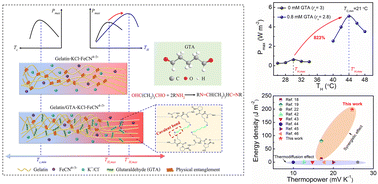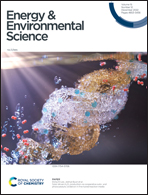Realizing record-high output power in flexible gelatin/GTA-KCl-FeCN4−/3− ionic thermoelectric cells enabled by extending the working temperature range†
Abstract
Quasi-solid-state ionic thermoelectric (i-TE) cells have attracted increasing interest due to their high thermopower and easy solution processability for flexible and wearable thermoelectric devices. However, many i-TE gels have drawbacks of a narrow working temperature range (ΔTmax) and low power density. In this study, we introduced glutaraldehyde into the gelatin-KCl-FeCN4−/3− matrix, forming strong covalent bonds and interconnected porous structures, which significantly improve ΔTmax from 9 °C to 23 °C. The formed gelatin/GTA polymer network increases the entropy difference between the redox couples of FeCN4−/3−, thereby enhancing its thermopower. For the first time, a high thermopower of 24.7 mV K−1, a record-high power density of 9.6 mW m−2 K−2 and a 2 h energy density (E2h) of 198 J m−2 are achieved simultaneously in a quasi-solid-state i-TE cell. The i-TE cell exhibits good cycling performance in long-term power generation, corresponding to an average E2h value of 175 J m−2 after the whole cycling process. A flexible and wearable device consisting of 16 i-TE cells can generate a high voltage of 3.6 V and an output power of 115 μW by harvesting body heat. This work provides a general route to increase the working temperature range and output power density of gel-based i-TE cells through a molecular-level approach.



 Please wait while we load your content...
Please wait while we load your content...